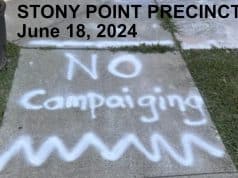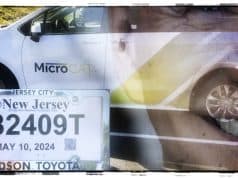Ridge-Cherry’s non-mystery history
by Antoinette W. Roades
At 6:30 pm on Wednesday, 9 September, Charlottesville Planning Commission and City Council will hold a joint public hearing to consider rezoning 2.875 acres at the intersection of Ridge Street and Cherry Avenue to Planned Unit Development (PUD) for a project that features an 80,000-100,0000 square foot mixed use building that is projected to substantially increase traffic at the intersection and on narrow adjacent streets.
To: members, Charlottesville Planning Commission and City Council
Date: 31 August 2009
From: Antoinette W. Roades
Re: history’s non-mysteries in respect to Ridge-Cherry
High on the list of deeply distressing aspects of the Ridge-Cherry situation is the fact that nothing put “on the record” ever seems to stay there. Over and over and over again, information is relayed only to vanish immediately from consideration. The history of the proposed William Taylor Plaza site and the Ridge-Cherry-Fifth-Oak block of which it is part constitutes such a body of information.
The history of that block is unique in Charlottesville and probably unique in Virginia. The block features on three sides antebellum dwellings all built by the same person, Allen Woodson Hawkins. And that person, who came here in 1818 as a teenaged bricklayer to help build the new Thomas Jefferson-designed “Academical Village,” is buried on the fourth side of the block that was his home for a quarter-century and where his kin continued to live for another 100 years.
That history, together with the details of more recent benchmarks like VDOT’s Ridge Street demolitions in the 1970s, should have been accurately conveyed in staff reports and should be informing all aspects of discussion by you, Board of Architectural Review, and City Council. Instead, it has been conspicuous by its absence and/or garbling.
Indeed, reviewing your 11 August discussion, one would think that there is some mystery about the block’s history and that history’s material legacy. There is no mystery. Some of that information has been “on the record” at NDS for decades. I have personally put that information “on the record” myriad times over five-and-a-half years in meeting testimony, e-mails, newspaper items, documentation packages hand-delivered to City Hall, ad inf. NDS staff members have made liberal use of that material when it suited their purposes. Apparently, thoroughly informing you has not suited their purposes.
WHO WAS WILLIAM TAYLOR?
The name William Taylor did not appear in any of the material I delivered for good reason. The choice of that name for Southern Development’s inappropriate project has nothing to do with the history of the block, nor does it attest respect for history in general. Instead, it is a pretense of respect meant to deflect attention from the block’s real history — that is, the history made by Allen Hawkins’ life and work and his burial on the site.
A man named William Taylor secured from the British Crown a patent on 1200 Virginia acres in 1737, four years before Albemarle County was formed from Goochland County and 25 years before the town of Charlottesville was established on 50 of those patented acres. (N.B. The property had left Taylor’s ownership well before the town’s founding.) Those 50 acres did not include the Ridge-Cherry area.
Beyond the occasionally noted fact of his 1737 patent, William Taylor does not appear in local histories. Indeed, John Hammond Moore, author of what is considered the definitive history of Albemarle County and Charlottesville felt no need to mention him, but did note: “In a sense, much that occurred in this region before 1744 can be classified as Albemarle County’s prehistory, not only Indian life but what white men did there as well.” The only appearance of a William Taylor in local deed books records the sale in 1768 of 30 acres in the North Garden area of Albemarle County. Taylor is described in that document as a planter in that still rural area.
But SD needed no book of any sort to find William Taylor’s name. His name can be found by anyone driving past any of the three identical state highway markers — one on Long Street, one on Route 29, and one on Route 20 — headlined “Charlottesville.” The markers’ first line reads: “This site was patented by William Taylor in 1737.”
A BLOCK’S UNIQUE BIOGRAPHY
The real and unique biography of the Ridge-Cherry-Fifth-Oak block begins in 1814 when Alexander Garrett acquired a large tract immediately south of the still tiny town of Charlottesville. Garrett — first bursar of the University of Virginia, Jefferson connexion, namesake of Garret Street and Garrett Hall (at U.Va.) — called the property on which he made his home Oak Hill (the reason the original name of Oakwood Cemetery was Oak Hill Cemetery).
In 1825, anticipating that the opening of the new university would raise the value of land between it and the town, Garrett had Albemarle County surveyor Achilles Broadhead plat his property into salable parcels. At the same time, he created on that platted property two new thoroughfares — Ridge Street (as “the Ridge road”) and, on the westernmost boundary of his land, Fifth Street (as “the new road to William Hening’s old stillhouse”) — and donated both to public use.
Broadhead’s 1825 plat also created the eventual street scheme within the parcels he drew. What may appear random today becomes a grid when no-longer-visible alleys and rights-of-way are factored in. That scheme was, of course, intended to accommodate horses, mules, oxen, and humans on foot, not thousands of modern automobiles plus school buses, fire engines, trash trucks, etc.
ALLEN HAWKINS’ BUILT LEGACY
In 1829, Allen Woodson Hawkins, who had remained here after his work on the Lawn-flanking hotels and pavilions had ended in 1824, bought Parcel 41 on Broadhead’s plat of Garrett’s land. That parcel included all the land now bounded by Ridge Street, Cherry Avenue, Fifth Street S.W., and Oak Street. The next year, Hawkins bought Garrett parcel 40, which included all the land now bounded by Ridge Street, Oak Street, Fifth Street S.W., and Dice Street. A few years later, he bought more land in the parcel immediately north of 40 — specifically, in the area now bounded by Fourth Street N.W., Dice Street, Fifth Street S.W., and the railroad tracks.
By 1832, Hawkins had built as his home 418 Fifth Street S.W. (City-designated historic as the Hawkins-Wondree House). In 1843, he built on Ridge Street the handsome Greek Revival mansion razed in 1963 to make way for Noland Company. In 1844, he built 505 Ridge Street (City-designated historic as the Bibb-Wolfe House). Beginning by 1850, he built the original portion of 402 Dice Street (City-designated historic as the Barksdale-Totty House). By 1853, he had built the core of 406 Oak Street (the Hawkins-Holmes House in K. Edward Lay’s addition to his definitive study of Jefferson’s builders) and 529 Ridge Street (razed by VDOT in the 1970s). By his death in 1855, he had also built the core of 418 Oak Street, at least the core of 220 Fifth Street S.W., and a dwelling in the 200 block of Fourth Street S.W. (City-designated historic but razed nevertheless).
Hawkins built many other houses — some of which undoubtedly still stand — both on his own property and further afield during a very active career that lasted 37 years. An inventory he made in 1853 would seem to confirm that he built the Ridge Street dwelling of Nancy Kinney, a free black woman of note. He is known to have built Judge Alexander Rives’ mansion at Carlton. That house, since lost to fire, stood in what is now Monticello Memory Gardens.
Hawkins also made bricks in partnership with Gen. John Hartwell Cocke, a cofounder of U.Va. and one of Virginia’s most prominent citizens for more than half-a-century, within sight of his home. He also trained other bricklayers and builders — black and white, slave and free. Among structures attributable to those he trained are 510 Ridge Street (City-designated historic as the Hodges-Gleason House), 401 Ridge Street (City-designated historic as the Presiding Methodist Elder’s House), 204 Seventh Street S.W. (City-designated historic as the Hawkins-Lee House), 208 Seventh Street S.W. (City-designated historic as the Hawkins-Parker House, 600 West Main Street (City-designated historic), and 422 North First Street (City-designated historic as the Watson-Bosserman House.)
THE HAWKINS FAMILY GRAVEYARD
Allen Woodson Hawkins died in December of 1855 and was buried in the family graveyard on his property. His second wife followed him in death barely eight months later and was undoubtedly buried with him. Given earlier family losses, the burying ground may already have received Allen Hawkins’ first wife and at least one child. Given family losses between Allen Hawkins’ death and 1883, when three of his adult children reserved the family graveyard by deed and also agreed not to enlarge it, that burying ground could hold the remains of as many as ten individuals.
The 1883 deed reserving the graveyard and the 1859 plat on which it depends were duly recorded by Albemarle County’s Court Clerk and are at hand. (Determining the precise boundaries of the surveyed lot on which the graveyard was reserved is a simple exercise in title search.) Together with abundant other evidence both circumstantial (like the continued presence of the Hawkins family on the block into the 1950s) and anecdotal (sightings of gravestones in recent memory) — they point to Parcel 157 on Tax Map 29 as the site of that cemetery. So the possibility of human remains lying on Parcel 157 is not “remote” as it was fleetingly described at your August 11 meeting.
DESTRUCTION OF EVIDENCE
In 1999, when Dr. Charles W. Hurt purchased five parcels (including 157) at the Ridge-Cherry intersection from the heirs of Lawrence Quarles, the U.Va. Engineering School dean who had bought them during the Depression, the property was far from “gone wild,” as it was described at your August 11 meeting. It featured a continuous canopy of mature trees beneath which the ground was almost completely free of undergrowth. However, an illegal bulldozing shortly after that purchase toppled dozens of those mature trees, ripped the continuous canopy, radically disturbed the earth, and thereby opened the way for invasive species and dense undergrowth. At the same time, that bulldozing undoubtedly destroyed the small gravestones that witnesses have recalled and thereby made an archaeological survey the only way to determine where they had stood and where remains still lie.
Southern Development’s approach to the high probability that human remains lie on Parcel 157 has been to ridicule those who make the assertion, demean the evidence, and employ deflection. For instance, all SD representatives dutifully repeat that SD’s lawyers have assured SD that no remains lie on the parcel. The intent is that hearers will be so impressed by the word “lawyers” that they will not notice the near-comic illogic of the statement. While any lawyer can confirm the validity of the Hawkins graveyard reservation, etc., no lawyer can prove that remains either do or do not lie on the pointed-to parcel. Only an archaeological survey can prove what does or does not lie beneath that illegally disturbed soil.
In private, of course, lawyers have made Charlie Armstrong aware of the liability SD faces. In Virginia, to knowingly disturb human remains is a felony chargeable as “Violation of Sepulchre.” Having been put on notice that remains lie on the site, no disturber could claim accident. So, even as he has asserted the absence of a Hawkins graveyard, word has it that he has taken archaeologists to its probable site at least twice. In one instance, the cost estimate of a proper survey apparently put him off. In another, he attempted to secure for free the services of an archaeologist who focuses on African-American burial sites by giving that archaeologist to believe that the Hawkins were black. They were not.
VDOT DEMOLITIONS
In your discussion of 11 August, the word “redevelopment” was used several times in relation to the Ridge-Cherry site. That use suggests a profound misunderstanding of where buildings did and did not stand earlier. Until the late 1970s, five handsome houses — at least one of them, and possibly all of them, the work of Allen Hawkins or one of the builders he trained — stood between 517 Ridge Street and what is now the Tonsler Park tennis court. Except for a very few small, insubstantial dependencies — chicken coops, a ramshackle shelter for a mule, etc. — no other structures ever stood in the core of the Ridge-Cherry-Fifth-Oak block. Deeds confirm that fact as do such other sources as early 20th century Sanborn Fire Insurance Maps, mid 19th century prints, and a circa 1867 photograph. (N.B. In the past, builders did not gouge steep slopes or obliterate streams to erect substantial structures. They had too much respect for nature’s physics.)
In the 1970s, the Virginia Department of Transportation bought three of the Ridge Street properties (numbers 521, 527, and 529) and invoked eminent domain to secure the other two (523 and 525), then demolished all five houses to create the west side of the current intersection of Ridge Street, Elliott Avenue, Fifth Street Extended, and Cherry Avenue.
Examination of documentation from the relevant transactions makes clear what any current observer can easily see. That is, that the stretch of Cherry Avenue between Fifth Street S.W. and Ridge Street was not engineered to be a street. It was engineered to be a ramp — an in-town version of a highway on-off ramp. As all such ramps do, it simply flies over the ground below. No attempt was made to relate it to the sharply sloping terrain of the property to the north of it. Documents state that that slope is to be “on the property owner” to the north. Clearly, no access or egress between the property and the new Cherry Avenue ramp was envisioned, nor was any needed because nothing requiring access or egress had ever been built there
N.B. Not only does the Ridge-Cherry property include precisely the sort of steep slopes the City’s steep-slope ordinance was designed to protect, it includes sheer drops. Consequently it can be built on only by completely destroying the existing landscape and creating grade changes so extreme that no mature tree would be likely to survive.
STRUCTURAL THREATS
In addition to opening the Ridge-Cherry property to invasive plants, the illegal bulldozing’s ripping of the continuous canopy on the low ground caused the water table in the surrounding high ground to drop. At 406 Oak Street, we began to lose trees and shrubs the following year. On the narrow lot that separates our property from SD’s Parcel 151, two large healthy sycamore trees began to decline notably. One is now almost completely dead and, therefore, constitutes a looming danger to all surrounding property owners. Even more serious, the back section of our house dropped inches from level and began to tear away from the front section.
Because the houses along the west side of Ridge Street were, like ours, built without footings directly on ground supported by sandstone bedrock, we presume that their stability has been similarly compromised. We know that further canopy removal will create further subsidence in the bedrock. Southern Development’s penchant for dynamiting sandstone could well result in complete collapse of existing historic structures.
YOUR CHARGE
In sum, the Ridge-Cherry-Fifth-Oak block has the sort of history that any community should be proud to celebrate and eager to preserve. At very least, the remains of Allen Woodson Hawkins, who created the block’s unique material legacy and contributed so substantially to building the entire community, should be protected and respected, not further abused and desecrated.
You have the responsibility to see that the right thing is done. You have the authority to require a full, professional archaeological survey of Parcel 157 before tons of fill are dumped there. A Hawkins descendant has called on you to do that right thing. So do I. So does history.








To have this information repeatedly ignored speaks to the caliber of city officials we have because of the people we elect. It has been clear to me for years that the only reason the city designates areas as historic is because that lh that designation design control That is why the city has held its two lots hostage for decades. It wants to determine how development in the city will look. It hasn’t realized that our local government has never designed anything of the order of what has been done without the city’s design input.
I hope Ms. Roades has enjoyed her research; she will not enjoy anything else about it.
Only hypocrites would enact steep-slope development restricts and then grant every petitioner a waiver. Only a hypocrite would enact stream protection measures and then grant waivers for the bribe of proffers. Only a hypocrite would press for increased canopies, then vote to destroy it. Only a hypocrite would campaign on public safety and then approve egress onto the middle of the steep hill between Ridge and Fifth streets. Only a hypocrite would harangue neighborhoods to participate in the process and then treat their voices with disdain. Only a hypocrite would involve the public in an 18-month rezoning process city-wide and then grant every rezoning petition on individual lots in total opposition to the neighborhood. Only a hypocrite would encourage citizens to participate in citizen leadership training and then spend then that time to teach the participants to trust City Hall’s direction and spend their time helping the officials attain their pre-determined goals. I suspect there will be fewer than five neighborhood residents attending the Planning Commission’s meeting on Sept. 8.
Dear Cville Eye,I am SHOCKED to find hypocrites in our fair city and community.